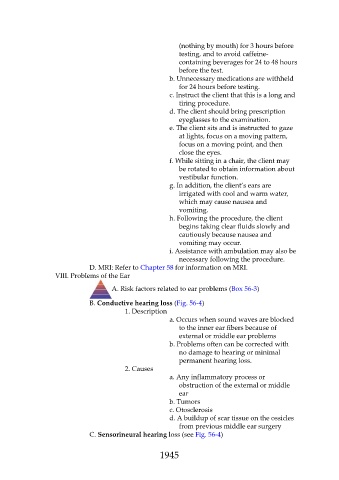Page 1945 - Saunders Comprehensive Review For NCLEX-RN
P. 1945
(nothing by mouth) for 3 hours before
testing, and to avoid caffeine-
containing beverages for 24 to 48 hours
before the test.
b. Unnecessary medications are withheld
for 24 hours before testing.
c. Instruct the client that this is a long and
tiring procedure.
d. The client should bring prescription
eyeglasses to the examination.
e. The client sits and is instructed to gaze
at lights, focus on a moving pattern,
focus on a moving point, and then
close the eyes.
f. While sitting in a chair, the client may
be rotated to obtain information about
vestibular function.
g. In addition, the client’s ears are
irrigated with cool and warm water,
which may cause nausea and
vomiting.
h. Following the procedure, the client
begins taking clear fluids slowly and
cautiously because nausea and
vomiting may occur.
i. Assistance with ambulation may also be
necessary following the procedure.
D. MRI: Refer to Chapter 58 for information on MRI.
VIII. Problems of the Ear
A. Risk factors related to ear problems (Box 56-3)
B. Conductive hearing loss (Fig. 56-4)
1. Description
a. Occurs when sound waves are blocked
to the inner ear fibers because of
external or middle ear problems
b. Problems often can be corrected with
no damage to hearing or minimal
permanent hearing loss.
2. Causes
a. Any inflammatory process or
obstruction of the external or middle
ear
b. Tumors
c. Otosclerosis
d. A buildup of scar tissue on the ossicles
from previous middle ear surgery
C. Sensorineural hearing loss (see Fig. 56-4)
1945

